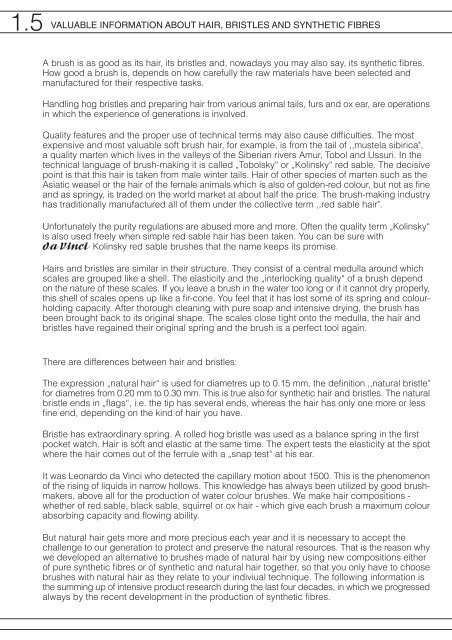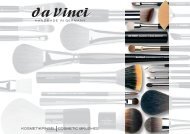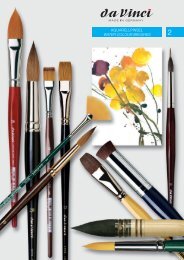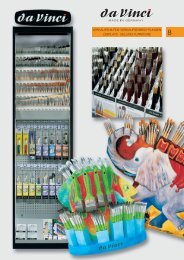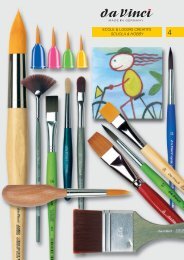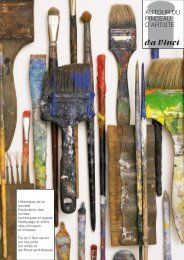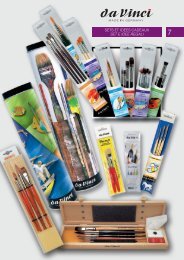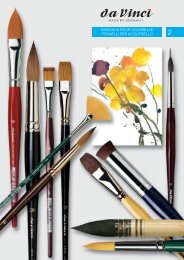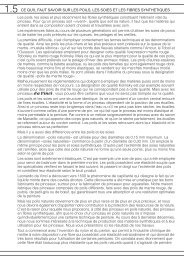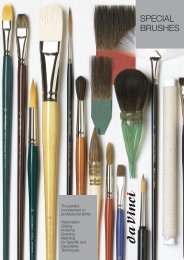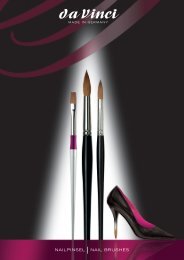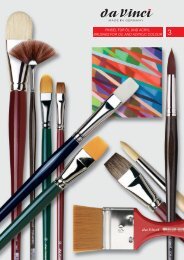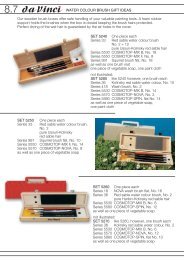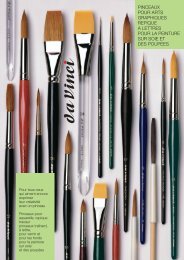1.0 THE ARTIST BRUSH RESOURCE GUIDE - da Vinci
1.0 THE ARTIST BRUSH RESOURCE GUIDE - da Vinci
1.0 THE ARTIST BRUSH RESOURCE GUIDE - da Vinci
Create successful ePaper yourself
Turn your PDF publications into a flip-book with our unique Google optimized e-Paper software.
1.5<br />
VALUABLE INFORMATION ABOUT HAIR, BRISTLES AND SYN<strong>THE</strong>TIC FIBRES<br />
A brush is as good as its hair, its bristles and, nowa<strong>da</strong>ys you may also say, its synthetic fibres.<br />
How good a brush is, depends on how carefully the raw materials have been selected and<br />
manufactured for their respective tasks.<br />
Handling hog bristles and preparing hair from various animal tails, furs and ox ear, are operations<br />
in which the experience of generations is involved.<br />
Quality features and the proper use of technical terms may also cause difficulties. The most<br />
expensive and most valuable soft brush hair, for example, is from the tail of ,,mustela sibirica",<br />
a quality marten which lives in the valleys of the Siberian rivers Amur, Tobol and Ussuri. In the<br />
technical language of brush-making it is called „Tobolsky“ or „Kolinsky“ red sable. The decisive<br />
point is that this hair is taken from male winter tails. Hair of other species of marten such as the<br />
Asiatic weasel or the hair of the female animals which is also of golden-red colour, but not as fine<br />
and as springy, is traded on the world market at about half the price. The brush-making industry<br />
has traditionally manufactured all of them under the collective term ,,red sable hair".<br />
Unfortunately the purity regulations are abused more and more. Often the quality term „Kolinsky“<br />
is also used freely when simple red sable hair has been taken. You can be sure with<br />
Kolinsky red sable brushes that the name keeps its promise.<br />
Hairs and bristles are similar in their structure. They consist of a central medulla around which<br />
scales are grouped like a shell. The elasticity and the „interlocking quality“ of a brush depend<br />
on the nature of these scales. If you leave a brush in the water too long or if it cannot dry properly,<br />
this shell of scales opens up like a fir-cone. You feel that it has lost some of its spring and colourholding<br />
capacity. After thorough cleaning with pure soap and intensive drying, the brush has<br />
been brought back to its original shape. The scales close tight onto the medulla, the hair and<br />
bristles have regained their original spring and the brush is a perfect tool again.<br />
There are differences between hair and bristles:<br />
The expression „natural hair“ is used for diametres up to 0.15 mm, the definition ,,natural bristle"<br />
for diametres from 0.20 mm to 0.30 mm. This is true also for synthetic hair and bristles. The natural<br />
bristle ends in „flags“, i.e. the tip has several ends, whereas the hair has only one more or less<br />
fine end, depending on the kind of hair you have.<br />
Bristle has extraordinary spring. A rolled hog bristle was used as a balance spring in the first<br />
pocket watch. Hair is soft and elastic at the same time. The expert tests the elasticity at the spot<br />
where the hair comes out of the ferrule with a „snap test“ at his ear.<br />
It was Leonardo <strong>da</strong> <strong>Vinci</strong> who detected the capillary motion about 1500. This is the phenomenon<br />
of the rising of liquids in narrow hollows. This knowledge has always been utilized by good brushmakers,<br />
above all for the production of water colour brushes. We make hair compositions -<br />
whether of red sable, black sable, squirrel or ox hair - which give each brush a maximum colour<br />
absorbing capacity and flowing ability.<br />
But natural hair gets more and more precious each year and it is necessary to accept the<br />
challenge to our generation to protect and preserve the natural resources. That is the reason why<br />
we developed an alternative to brushes made of natural hair by using new compositions either<br />
of pure synthetic fibres or of synthetic and natural hair together, so that you only have to choose<br />
brushes with natural hair as they relate to your indiviual technique. The following information is<br />
the summing up of intensive product research during the last four decades, in which we progressed<br />
always by the recent development in the production of synthetic fibres.
1.6<br />
To<strong>da</strong>y we use a large number of synthetic fibres of different diametres, whose tips taper out<br />
extremely fine like needles. We use these new fibres the same way as for the production of<br />
brushes of natural hair in order to perfect our assortment of products. The high stability and the<br />
extraordinary spring of the new synthetics are particular characteristics most prized by our brush<br />
makers to<strong>da</strong>y. These superior qualities in synthetic fibres permit new combinations of fibres and<br />
new techniques of production. The result are synthetic water colour brushes having an aura<br />
around the brush tip which is not inferior to that of red sable.<br />
The inimitable „inner life“ of a true red sable brush will remain a secret for the synthetic brush.<br />
Based on Leonardo's discovery - to absorb and conduct a lot of liquid, we found it necessary<br />
to solve this problem by developing compostions of natural hair and synthetic fibres. It was<br />
necessary to „mix” the traditional hair like sable, squirrel and ox hair, which are used particularly<br />
for the production of water colour brushes, with extremely soft fibres which have very fine tips,<br />
in a way that the painting of longer sequences without interruption is also possible in perfection<br />
with a synthetic - natural hair brush. During this course of developments we were advised by<br />
known water colourists.<br />
And this is the chronicle of this product range:<br />
1965 with the introduction of the acrylic colour we placed at the disposal of amateurs and<br />
artists the -MAESTRO-ACRYLIC-brush. These brushes made with interlocking<br />
effect had already and at that time an unexpected good spring permitting an equal colour<br />
distribution.<br />
1976 the -NOVA brush is presented, first with white and later with golden coloured<br />
hair and from the beginning with a fir-green handle. To<strong>da</strong>y this is certainly the<br />
universal brush for tempera and water colour, for oil, acrylic colour and hobby techniques.<br />
(series 18 - 122 - 1370 - 1375 - 1570 - 1670 - 1870 - 1875)<br />
1984 the -NOVA-MIXED, series 1572, is put on the market and is appreciated by<br />
amateurs and artists as a cheaper alternative to the red sable brush, due to the high<br />
effect of capillarity.<br />
1990 the -COSMOTOP-SPIN enlarges the great water colour tradition of our house<br />
with the pure fibre brush series 5580 and 5584 pointed and in oval shape.<br />
1991 the -COSMOTOP-MIX, series 5530, significant by its blue transparent lacquered<br />
esagonal handle, made of a composition of the classical natural hairs combined with a<br />
special synthetic fibre, has become a treasured, economic water colour brush - above<br />
all in the large numbers - during more than a decade.<br />
1992 the -TOP-ACRYL enlarges our assortment in the fibre brush range<br />
1997 after a longer testing period introduces the -JUNIOR,<br />
the first fully synthetic school painting brush - first in ROUND (series 303) and the following<br />
year in FLAT (series 304)<br />
2000 the Paint-Finger, the colourful great fun brush comes out.<br />
As ideal aid in developing hand to eye coordination skills in young children and encouraging<br />
creativity it gets very popular in kindergardens and for ergotherapy.<br />
2001 -FORTE with its robust fibre quality complements our brush assortment for<br />
leisure artists that are used to work with thicker colours on rough surfaces.<br />
2002 -PRIMO - the brush for the youngest beginners, developed on the basis of<br />
the very successful -JUNIOR, is welcomed unanimously by experts.<br />
2003 -IMPASTO has been developed as the flexible “painting knife-brush”.<br />
Flats, rounds and mottlers (series 7105, 7705, 5025) are ideal for these demands.


